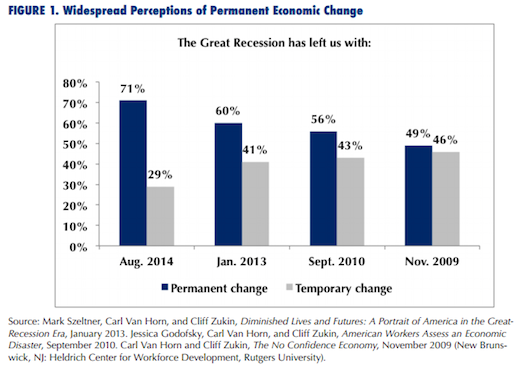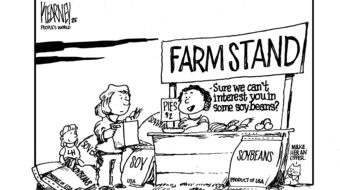
HARPER’S FERRY, W Va. – It’s easy to feel you are being pressured against your intuition and instinct to accept a miserable marriage when listening to many economics pundits, columnists and bloggers trying to be “upbeat” about the economy. This is the case with more than a few liberal, as well as ordinary pro-business writers.
For example, the President, the Economist, the editorial pages of the Washington Post and other papers, all tout the steady “progress and recovery” reflected by recent declines in the official unemployment rate. The last paragraph of the best of these articles will mention, but not explain, that unemployment stats can decline because millions are simply leaving the workforce, as they are doing, and creating that “standing at the altar” feeling of abandonment. Are they sick of the low wages? Is it because the baby boomers are forced to retire early because of jobs destroyed in the 2008 depression? Is it because of so-called “structural” problems in matching jobs to existing skills? Is it because of the Republican juggernaut that we impose the miserable failure of austerity economics to substitute government action to aid job creation? Why, for example, are young people among the biggest forces virtually locked out of the workforce since 2008? No one seems to know.
Despite the flattery of pro-biz writers, many Americans feel gloomy about the economy. Here in Jefferson County, W. Va., I periodically ask people how they think “the recovery” is going. Most often, I get a deer-in-the-headlights look, followed by “huh?” And Jefferson County is doing better than all other West Virginia counties due to some increase in local tourism as a consequence of D.C. area folks looking for a quaint, but cheaper vacation destination.
Explaining the gloom are two graphs from Jared Bernstein’s economic blog. They show the gaps between real GDP growth, corporate profitability, the stock market, and middle-class household incomes.
The graph above shows modest improvement in Gross Domestic Product — the usual baseline for economic growth. But corporate profits and the stock market are increasing 4 and 9 times the GDP growth rate, while median family income — the broadest measure of working people’s economic health — has declined 3% since the onset of the 2008 crash and depression!
Despite rosy press stories about recovery, the American people are not buying it, as the results of the poll below dramatically show:

The poll demonstrates the increasing loss of hope by American workers that more positive pre-Reagan trends in wages and incomes will return. It will take numerous years, at full employment, to even repair the enormous damage of this depression — estimated by Jared Bernstein to be an average annual $7500 per household.
Think about it: A full employment economy is an economy that must: a) completely reject austerity politics; b) raise the minimum wage; c) return proportional increases in worker productivity to workers’ wages and salaries; d) greatly expand worker bargaining power and rights; e) tax outsized 1 percent incomes to pay for doubling educational, infrastructure, and environmental performance.
How close can we get to that without virtually overthrowing the corporate and billionaire dictatorship that seems to be emerging?
Time to leave behind the flirtations with economist spin doctors, and find some real partners!
Graph source: BEA, Standard and Poor, Sentier Research.










